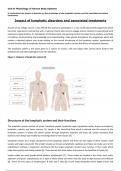Essay
BTEC Applied Science Unit 8B - Lymphatic system (Distinction)
- Course
- Institution
- Book
Exemplar assignment for Unit 8B, the second assignment in BTEC Applied Science Unit 8. This assignment was given a DISTINCTION. If you take anything from this assignment, please put it in your own words otherwise it will count as plagiarism! I hope it helps!
[Show more]




